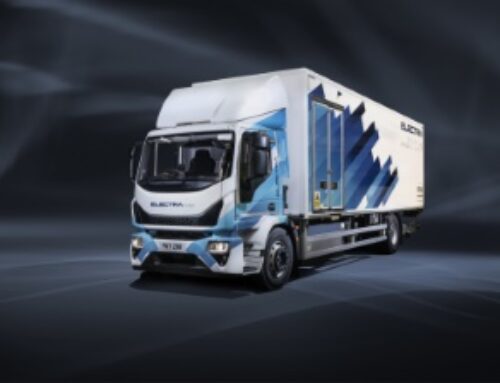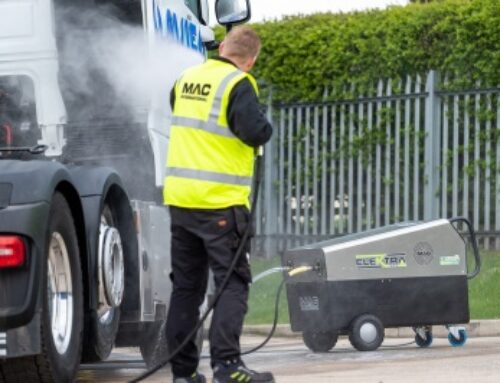Brigade: operators put at risk by DVS delay
Fleet operators who are not yet compliant with Transport for London (TfL)’s Direct Vision Standard (DVS) requirements must not become complacent, a leading road safety expert has warned.
Enforcement of the DVS and safety permit scheme was initially to be implemented from 26 October, and has now been postponed to 1 March due to the Covid-19 pandemic.
But vehicle technology provider Brigade Electronics has warned that the regulations are already a legal requirement as of the original date – so that even prior to March, a driver or operator could be deemed liable for vehicles not being fully compliant in the event of an incident or insurance claim.
 Brigade’s Emily Hardy (pictured, right) says there remain unanswered questions as to whether, in the event of an incident, operators could be responsible for civil damages, and insurers may not be obliged to pay out.
Brigade’s Emily Hardy (pictured, right) says there remain unanswered questions as to whether, in the event of an incident, operators could be responsible for civil damages, and insurers may not be obliged to pay out.
“Simply put, delaying the fines is not the same as changing the date of the legislation,” Emily said, advising operators to consult their legal representatives and insurers before weighing up the risks.
Transport Operator raised the issue with TfL in June, who told us that suspending or deferring the legal start date was not possible, as it would delay the introduction of the scheme.
“Not complying with the scheme wouldn’t automatically lead to liability in the event of a collision,” said a TfL spokesperson.
“Whether freight operators would be liable in civil or criminal proceedings would primarily depend on the circumstances. However, compliance with best practice safety standards would be relevant.”
Brigade, which has been at the forefront of the vehicle safety market since 1976 when it introduced the reversing alarm into the UK, has been urging operators to meet the original deadline or at least conduct a risk assessment.
“If they haven’t already, they should check their star ratings and have a plan in place to retrofit vehicle safety devices if required,” Emily Hardy added.
Brigade has raised other concerns with TfL’s DVS, warning that its focus on direct vision – where the driver sees through unimpeded line of sight – at the expense of indirect vision – where drivers have an awareness of their surroundings through camera monitor systems and ultrasonic obstacle detection – is ‘misguided’.
 TfL claims drivers using indirect vision have a slower response time, resulting in an increased incidence of simulated pedestrian collisions. But direct vision also has its limitations, according to Brigade’s founder and chairman Chris Hanson-Abbott OBE, who says cameras, sensors and reversing alarms are vital tools to prevent collisions.
TfL claims drivers using indirect vision have a slower response time, resulting in an increased incidence of simulated pedestrian collisions. But direct vision also has its limitations, according to Brigade’s founder and chairman Chris Hanson-Abbott OBE, who says cameras, sensors and reversing alarms are vital tools to prevent collisions.
“TfL’s research is flawed and simplistic when it comes to technology,” he said.
“No-one is doubting the importance of direct vision, but it relies on the driver looking in the right place at the right time to see the potential danger.
“Safety technology is more than just indirect vision. It includes passive and active systems that alert the driver to something in their blind spot – which encourages them to look.
“The TfL guidelines create an impression that if you have direct vision you don’t need to fit sensors and other tech. This is a backwards step and diminishes the good work of schemes like CLOCS and FORS that have raised industry standards.”
Brigade cites recent research by the European Transport Safety Council suggesting that 25 per cent of road deaths in the EU involve a goods vehicle, indicating that there is still much to be done in preventing such deaths and injuries.
Driver visibility is key to this, says the firm, and what a driver can see from their position inside a vehicle plays an important role in directing road safety legislation, including London’s DVS.
However, direct vision – what is seen through the windows – is not enough to prevent collisions caused by blind spots, warns Brigade, as it can be limited by various factors, including dirty windows, sun glare, cab height, vehicle length, passengers obscuring glass doors, and the distance and height of a vulnerable road user in relation to the vehicle itself.
While driver visibility can be aided by passive systems, such as mirrors and cameras, these still require driver input in order to spot objects or people, the firm points out; in the time it takes a driver to check mirrors and react, a vehicle could travel as far as 10 metres, even at speeds as low as 3mph.
 “While passive systems, such as mirrors, have been a legal requirement for many years, mirrors alone will not solve the blind spot problem,” said Emily Hardy.
“While passive systems, such as mirrors, have been a legal requirement for many years, mirrors alone will not solve the blind spot problem,” said Emily Hardy.
“If the driver is not looking, they will not see that something is in the immediate vicinity of their vehicle. This is why vehicle safety systems that require a driver to take immediate action through the provision of audible alerts and warning sounds are crucial to maintaining the highest road safety standards.
“These active systems will notify a driver instantaneously when a vehicle or object is in their blind spot, ensuring a driver can react immediately and prevent a collision.”
She added: “Many collisions with large vehicles occur when they are manoeuvring at low speeds, such as turning left or reversing. Preventing deaths and injuries, as well as damage to objects and vehicles, can be reduced dramatically when a driver’s indirect vision from the cab is improved. We always recommend a combination of passive and active vehicle safety systems to be installed for ultimate safety.”
Brigade has also produced an infographic demonstrating the importance of vehicle safety systems to improve driver visibility and how both passive and active systems help support and improve road safety:












